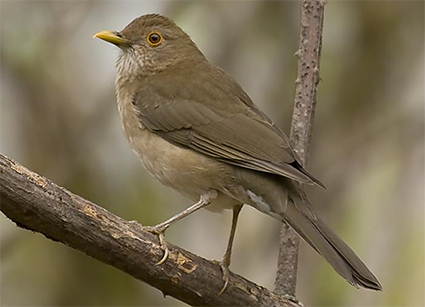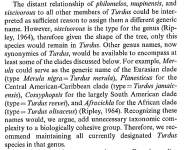We can therefore suggest that musicus is the type species since it is cited first. A later work would have had to explicitly give musicus as a type species
Being cited 'first' does not give a species more 'right' to become the type.
(
musicus was cited by Webb & Berthelot from Linnaeus 1766 [the page number they cited matches this edition of
Syst. nat.], but not as a deliberate adoption of a misidentification of the name: the type of the genus-group name could only be
Turdus musicus as defined where its name was made available, i.e., in 1758.
This name is a bit problematic, as it was originally published with a diagnosis of Redwing (Linnaeus apparently interchanged the diagnoses of the Song Thrush and Redwing, quite possibly by mistake -- most of the refs he cited under
musicus concerned the Song Thrush, and most of those he cited under
iliacus concerned the Redwing; he corrected this in his subsequent writings -- first in the
1761 ed. of Faun. svec., then in the 1766 ed. of
Syst. nat.).
musicus was moved onto the Redwing by Hartert in 1909 because of the 1758 Redwing diagnosis: this move is at the origin of our use of
philomelos Brehm 1831 for the Song Thrush; the name was finally suppressed by the Commission in 1959, to preserve the use of
philomelos and
iliacus for the two species.)
OD
1 - 2 (1837-38) - Naturalist (Maund, Hall & Wood.) - Biodiversity Heritage Library
Morris' work was an attempt to compile a list of British birds under strongly idiosyncratic rules, which i.a. stipulated that all generic names should be 'classical' Greek and all specific names 'classical' Latin. Although, from a taxonomic viewpoint, the author's intents were generally made clear by the English names he associated to his scientific names (he did not describe the birds or give an authority for any name in his list), I do not believe that his names can be deemed available as
nomina nova, because he nowhere presented any individual name as being rejected and replaced with the names he was using. In a number of cases, which name would have been intended is not actually clear. Why is
Nyctimene a new name for
Flammea Fournel 1836, not for
Aluco Flemming 1822? Why is
Philomela a new name for
Sibilatrix Kaup 1829, not for
Ficedula Koch 1816? Why is
Aedonis a new name for
Luscinia Forster 1817, not for
Sylvia Scopoli 1769? I think this type of interpretations is simply too subjective to be tenable. The truth is that Morris did not indicate what, if anything, he was replacing, and that his names should stand based on what he actually told us in his work -- things that we don't need to guess. In my reading, the only way that some of Morris' names can be available is under ICZN 12.2.5, for those among them that were (explicitly) combined with one or more recognizable available species-group names ; I view those that were combined only with specific epithets which Morris had also changed (and were thus not pre-available species-group names; e.g. "
Epops upupa" instead of
Upupa epops, for the "Hoopoo" --
upupa had never been used as a specific name for this species before) as pure
nomina nuda.
The originally included nominal species of
Lamprophonus were
Lamprophonus musicus (=
Turdus musicus Linnaeus 1758),
L. variegatus (a corruption of
Turdus varius Horsfield 1821),
L. viscivorus (=
Turdus viscivorus Linnaeus 1758), and
L. pilaris (=
Turdus pilaris Linnaeus 1758), plus
"L. turdus" (for Redwing, a
nomen nudum, hence not eligible to be the type); we would need a type designation, but I'm not aware that one was ever published in a Code-compliant way.
Although
Lamprophonus Morris 1837 is not in use, deeming it unavailable (due to the lack of authorities or descriptions associated to the species) seems undesirable, because it would be destabilizing to entomology (its availability is the reason of the use of the
nomen novum Lampetes Andrewes 1940, instead of
Lamprophonus Bates 1889, in Coleoptera).












